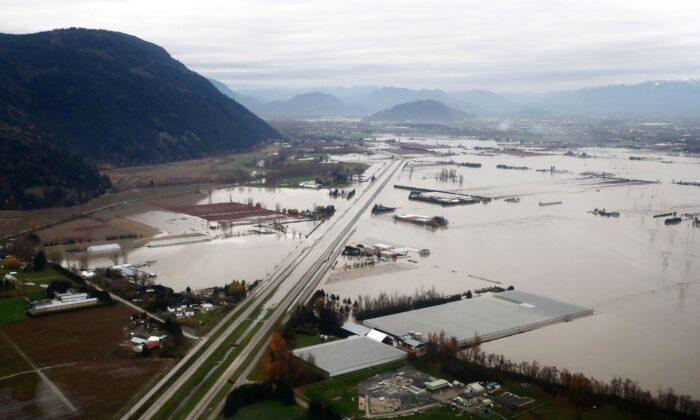As a former U.S. Army Sergeant, Jeffrey McCaskill once taught survival skills to soldiers. Now, the 58-year-old North Vancouver resident leads the Ready to Thrive Survival School to help prepare civilians for urban and wilderness survival.
McCaskill’s eight-hour urban survival class is offered to groups of about a dozen people, with three hours on a Friday evening and five hours on Saturday, starting in the morning. He said his students range from new parents to the elderly.
“I’ve been humbled by the array of students. I had a woman two classes ago from Singapore, 70 years old, and she came against the wishes of every family member. They thought she was off her rocker to even be considering this kind of stuff. It’s amazing. And she actually teared up sharing her story,” he said.
McCaskill said an earthquake, a flood, or an electromagnetic pulse attack are scenarios that could disrupt normal life for weeks. He recommends people stock a month’s worth of food, water, and supplies.
“Having that food onsite keeps you from having to find it elsewhere and putting you in the crosshairs of nefarious actors out there on the street who will definitely show up. They’re going to be looking for food, ammunition, water, drugs—illicit, and legal ones too—and medical supplies, maybe clothing, and fuel for their vehicles,” he said.
McCaskill has some advice for people who find themselves confronted with that kind of scenario.
“Make your place looks uninhabited. Use blackout curtains or garbage bags that are taped up so that errant light doesn’t leave the windows. I even teach my students how to camouflage their homes, their front yards, to make their places look like they’ve already been looted,” he said.
Importance of Water
McCaskill said floods in the southern part of B.C. a year ago washed out bridges and cut him off from his “bug-out property,” a five-acre, off-grid organic farm near Princeton that includes a 32-foot greenhouse. He said the situation was a “real lesson” that led him to anticipate a wider range of scenarios.“Hydration is a big problem, so I encourage people to get those water flavouring drops because they'll get weary of drinking just plain water. I set them up with a three-bucket system whereby they can ensure that the water that they have is actually safe to drink,” he said.
“If you still have water in your tap, you fill every pot, every vessel you can. In fact, some people fill their bathtubs. They draw water out of their water heaters. That’s 50 to 65 gallons.”
The tap will likely run dry in about three days, he says, after which it will be necessary to venture outside to find a source of water.
“And that’s where the danger comes in. You’ve got to move as a party and move tactically to minimize your exposure. Dusk is a good time to be moving without being detected.”
McCaskill advises acquiring a waterproof and fireproof safe to preserve essential documents. He also recommends preparing a “bug-out bag”—an emergency survival kit—weighing 30 pounds for men, 20 pounds for women, and 15 to 18 pounds for children.
Although protecting your provisions from strangers is part of survival strategy, McCaskill also encourages people to form relationships with those they can trust.
“I emphasize community-based networks where you outreach through a barbecue or something to your immediate neighbours or [even nearby blocks],” he said.
“Find out who’s awake, who’s interested in prepping themselves, and then you join forces, you combine your resources. If somebody is a welder, now everybody has access to a welder in your mutual aid network.”
McCaskill said his own network includes a group called Union of the People. Some of his students have taken canning classes from the union, and he hopes to add a class on knife-making. He’s also working on a book on prepping because he believes too many misguided sources fill the internet.
“If you go on a website and somebody sounds eager for chaos and the apocalypse to occur, and they’re lusting after all these weapon systems and talking about the massive amounts of ammo they have and how they can’t wait to get it on—you’re dealing with an idiot.”
Level one covers basic shelter construction, fire making, map reading and land navigation, animal tracking, basic bush crafting, wild plant foraging, making simple traps and snares, and water catchment techniques.
A Rural Option
In southeastern Saskatchewan, the Living Streams Institute offers courses for “homesteaders, preppers, and freedom fighters,” to help anyone wishing to become less dependent on government and mainstream supply chains.Its founder, John Graff, a pastor, consultant, and sheep farmer from Whitewood, Sask., says the institute exists to “give people hope” who might otherwise “see no way out” in dark times.
“The purpose is to equip employees, employers, and everyone for supply chain issues and energy shortages, and how to deal with societal structures,” Graff told The Epoch Times.
Off-grid energy classes teach how to make a home space heater, produce biodiesel, replace oxyacetylene with fuel made from water, implement solar power, and even have an off-grid fuel source for a home power generator. Each aspect takes one to four days. Graduates take home a working unit and have the skills to use it and to repair it if necessary.
“Many classes are hands-on, where the participants learn not just technical aspects and theory but they actually build or do the tasks. Some classes are done over the internet in live webinars, but many need to be in person to undertake the hands-on aspect,” Graff said.





